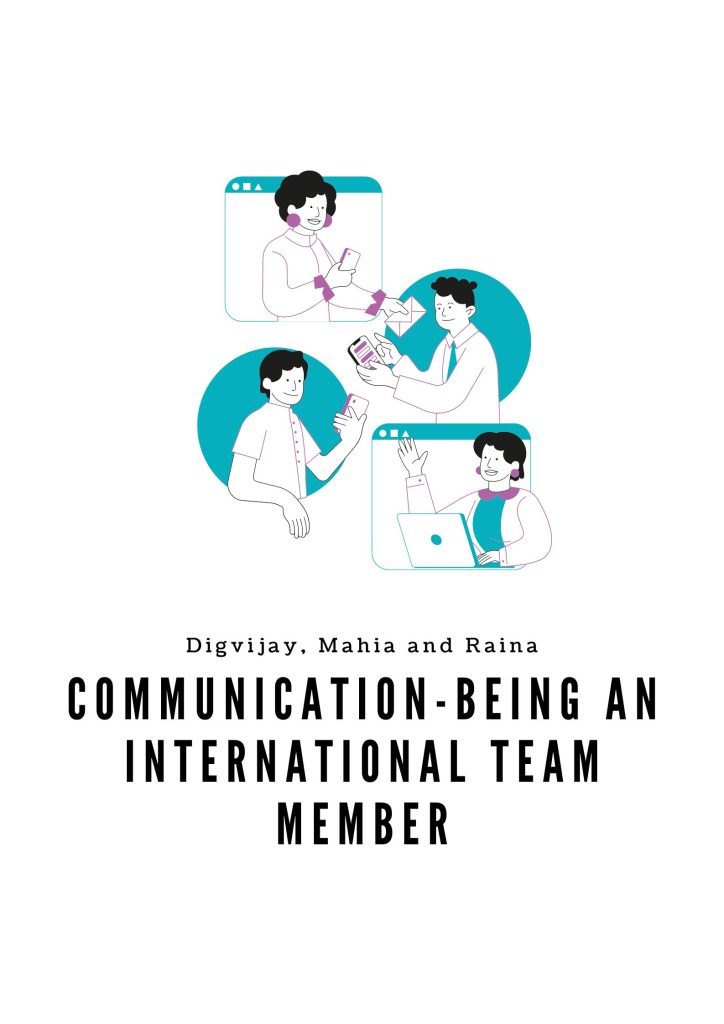
Communication-being an international team member
Esseen tyyppi: Akateeminen essee / 3 esseepistettä.
Abstract
Communication is not so common. This essay aims to address the effective ways of communication, verbal and non-verbal communication, struggle, language barrier and science behind communication.
Being part of a very new international team in Proakatemia has given us an opportunity to experience communication in a whole other level. This essay will consist of our experience and theories of communication in detail for the readers to understand the importance of the chosen topic.
CONTENTS
2 Verbal and non verbal communication 6
2.1 Expressing emotions and concerns. 6
2.1.1 Science behind expressing verbally. 6
2.2 Non Verbal communication. 7
2.2.2 Science behind non verbal communication 8
3.1 The struggle as an international team.. 9
3.1.1 Cultural differences and languages. 9
3.1.2 Culture and body language. 9
3.1.3 How does it affect in the business world. 9
1 INTRODUCTION
Communication opens the doors to success, if mastered. Being a young entrepreneur in a group of international students surely is a fruitful experience. Coming from different cultures and values, we team members sit together and make things work together. Sometimes its knowledge sharing or just discussing and sometimes it is taking vital decisions. All this is done through communication but it is not only verbal and not always very clear. This essay aims to understand the science, struggle and benefits of communication through our experience and various theories of communication.
Communication as an entrepreneur:
Communication in business is very important and is more of a necessity. To communicate is to make people understand what you are thinking as a team leader or member. If you do not communicate properly, your thoughts or instructions could be misunderstood which might create problems within the team. Being an entrepreneur, you have to put yourself out and develop your network to have better business opportunities. For an entrepreneur communication is a medium to make people feel and understand you and your ideas. Communication can be non- verbal too, like the body language you use shows who you are as a person and it tells a lot about your business abilities too.
Communication as a team member:
Communication as a team member is different and really important as it saves the team from falling apart. Being a team member sometimes people feel lost in their own team which is demotivating. To prevent this, you as a team member should speak and express your concerns as much as you can so that the team acknowledges you. To make a project successful coordination of team members play a vital role, as if the communication within the team is not working then it might delay the action plan of the project. As a team member you should make sure that you and your teammates mental and emotional health is taken into consideration and therefore expressing it will save the team from a lot of future conflicts.
2 Verbal and non-verbal Communication
2.1 Expressing emotions and concerns
Expressing is itself a mental therapy. In simple words if you store garbage in your house for a long time it will only get worse. Similar to garbage if you store your anger and sorrow within yourself, it will get worse and at one point it will blast out in the worst situation possible.
So why should we express our emotions regularly? Well, if you do so your mind will allow you to express it in the best manner possible, instead of an overflow of emotion and anger in a very inappropriate way. While you should also express your concerns on the topics which need your opinion as it’s the only way to solve the issues instead of it creating a drama once the project begins.
2.1.1 Science behind expressing verbally
CMM is a theory which is really suitable for communication in a Proakatemia team. According to the CMM theory by dialogue and discussions team members create a shared reality. When dialogues are involved, members bring in their own perspective and knowledge inside the team. The knowledge they have is influenced by the culture and background they come from which is important to know as it shows how a team member would behave. It is connected to verbal expression and communication as it reflects the dialogue system used in Proakatemia. This allows all team members to speak and express themselves on times which creates a shared reality and keeps a team together to achieve a goal. (Pearce and Cronen 1970, as cited in Hober 2023.)
2.2 Non- Verbal communication
Communication itself is an art and not everyone is a good artist. A non-verbal communication simply means that no words are involved and yet the message is conveyed. For instance, if you are angry on someone your eyes, actions or behavior is enough to make others realize your feelings. Similarly, if you are someone who cannot make eye contact while speaking, it reflects that you are nervous or not interested. These are some of many examples for a non-verbal communication.
Why is non-verbal communication important? It is simple. Imagine as an entrepreneur you have to perform a pitch and if you are not confident your body language will make it obvious for everyone. If you are not confident enough through your body language then it is already off-putting for your investors and team members and you would not like the results of it.
2.2.1 Body language
If computer can have a language, then why not the body? In simple terms a good body language reflects you are confident and gives a positive energy. For instance, having a smile, eye contact and a good body posture is generally signs of confidence in general.
2.2.2 Science behind non-verbal communication
Albert Mehrabian’s 7-38-55 rule is a good suit for this subject. According to this theory communication is divided into three parts which is 7% verbal, 38% Vocal and 55% non-verbal. This means that more than half of the communication is non-verbal which makes it vital for us to master it. (Albert Mehrabian 1967, as cited in Belludi N. 2008.)
3 Culture in communication
2.1 The struggle as an international team
As an international team we have people coming from very different and diverse culture. Having diverse cultures in a team also means that there will be different dialects, language (verbal and non-verbal) and many more. Sometimes its interesting to learn new things from each other and sometimes it causes misunderstanding.
3.1.1 Cultural differences and language
Coming from a different culture we always find ourselves struggling to understand Finnish language. At some point we Internationals felt lost in these cultural differences. Similarly, we Internationals use to talk in our own language which caused some misunderstanding and differences. Soon this behavior from the internationals and natives ripped the team apart from each other.
What did we do? Well, we used dialogue and communication as way to break our language barriers. We decided to use only English even when talking to someone who speaks the same language as ourselves. Doing this everyone felt involved and a bridge was created through communication which solved our differences at some extinct.
3.1.2 Culture and body language
Now you might be thinking that how is body language related to culture? Is it not individual? Well, at some extinct it is individual but it is also influenced by the culture and surroundings we come from. For instance, while speaking the neck movement of the Finnish people is not much but as an Indian when I speak the neck movement is more like a roller-coaster. This is a bit funny as for Finnish people its difficult to understand if they are really interested as we don’t see any neck movement, similarly the neck movement is a bit weird for the Finnish people.
The neck is just one of many examples which are not individual but a culturally influenced body language, it is not a problem but reflects differences.
3.1.3 How does it affect in the business world?
The anxiety/uncertainty management (AUM) Theory by William B. Gudykunst. The AUM theory explains the science behind these misunderstandings and problems which an international team face. According to the theory there is some anxiety between individuals when they have a cross cultural encounter, this makes them avoid communication causing misunderstanding and problems. (Littlejohn, Stephen & Karen 2009, as cited in Mahestu & Kustiawan 2016.) This happens because of less information or uncertainty to how an individual might react to certain things.
How do they solve it? According to the theory there are two ways one is cognitive in which people obtain more information and then communicate or the second way which is effective to build confidence, manage emotions and then communicating. Both these ways are very efficient to build a bridge in communication for a cross cultural encounter.
3 Personal reflection
3.1 What we learnt
Doing this essay, we came across various models and theories of communication which we had to study in order to use it in our essay. we were able to relate and share some of our experiences through these theories which increased our understanding about our own communication skills. we also understood how a international team can solve their communication problems with some of these theories.
3.2 Limitations
we were not able to reflect on the theories in depth but it can always be studied individually if needed.
REFERENCES
Hober, L. 2023. Top 5 theories about communication you need to know. Updated 05.03.24. Read on 06.03.24. https://www.teamazing.com/theories-about-communication/.
Belludi, N. 2008. Albert Mehrabian 7-38-55 rule of personal communication. Updated 05.10.2008. Read on 06.03.24. https://www.rightattitudes.com/2008/10/04/7-38-55-rule-personal-communication/.
Mahestu, G. & Kustiawan E. 2016. What you need to know about anxiety/uncertainty management theory. Updated 05.04.2016. Read on 06.03.24. https://communication.binus.ac.id/2016/04/05/what-you-need-to-know-about-anxietyuncertainty-management-theory/.



